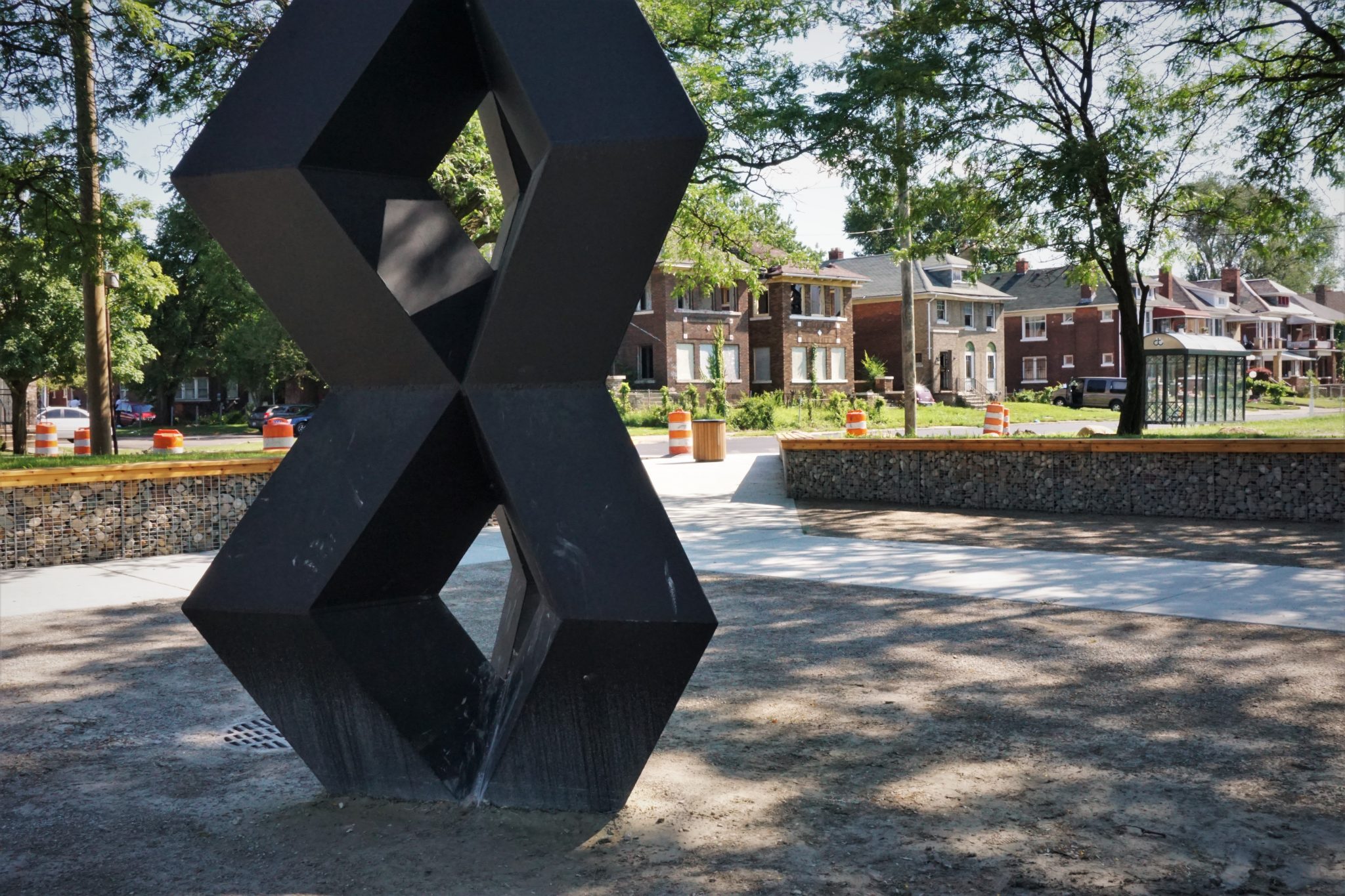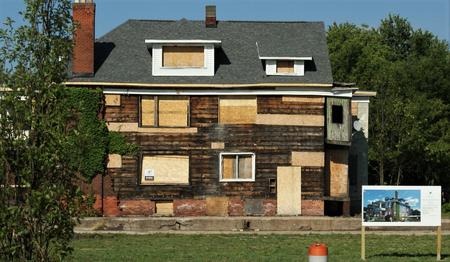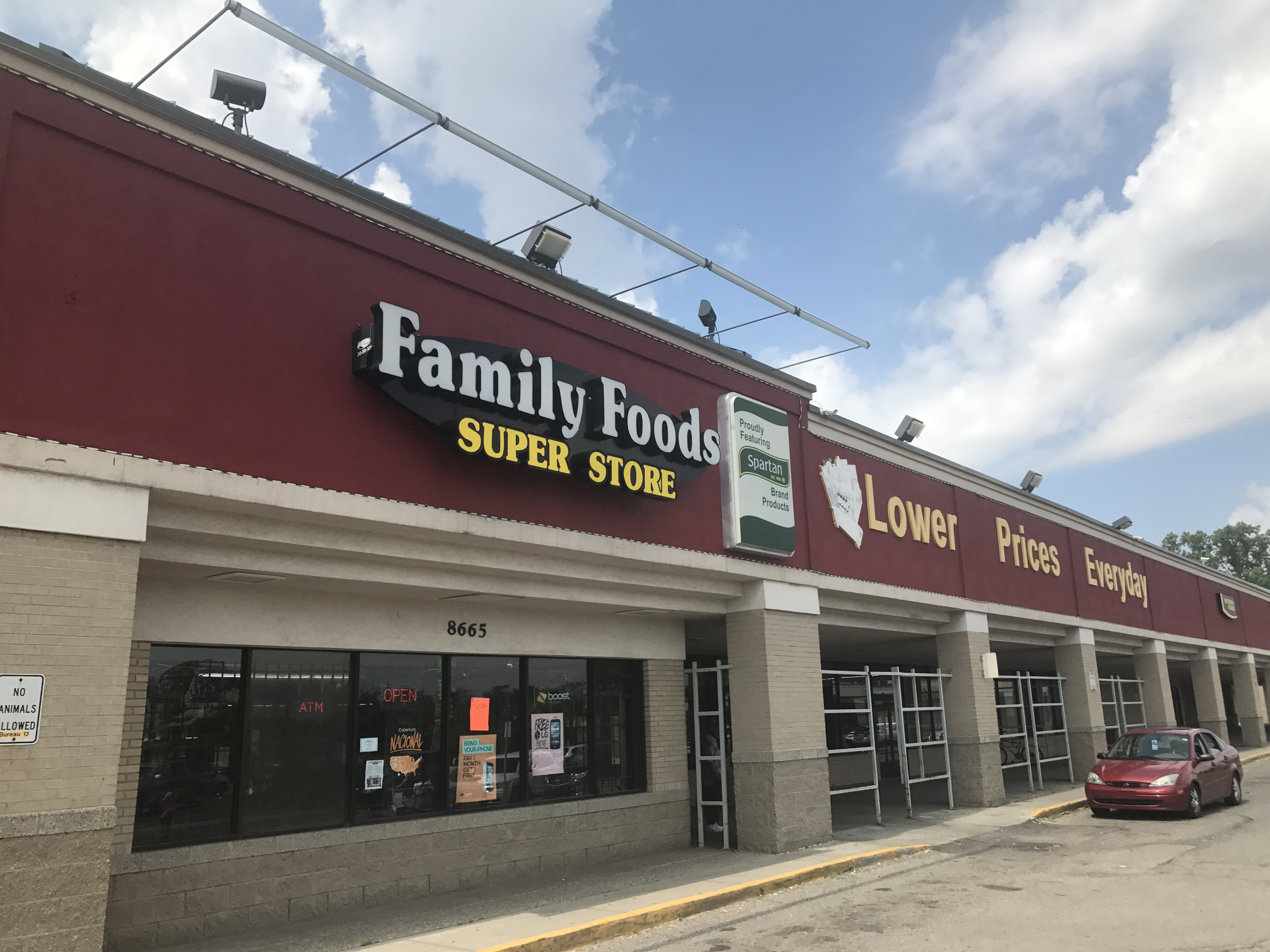12th and Clairmount Shows Scars And Signs of Hope
A monument, a park, and development come to the corner where the uprising began.

Editor’s note: Pat Batcheller originally filed this report in 2007. It has been updated.

The intersection of 12th and Clairmount in Detroit still bears some scars from the violence the broke out there in July 1967. Those who lived in the neighborhood long after the uprising still talk about how it changed.
“People started moving out,” says Tamela Jones. “Older people started dying off. And it has changed.”
Jones grew up on Hazelwood Street, just two blocks south of 12th and Clairmount. She was born after the riot, so she doesn’t remember what happened. But she has learned a lot about it from reading newspaper clippings, probing library archives, and talking to neighbors who do remember. She wrote a script for a movie that she planned to call “From the Ashes”. It’s about a man who relives the riot in his dreams. It turns into a wake-up call.
“The guy goes through this, and he’s just tossing and turning in his nightmare,” Jones says. “And when he comes to, he’s in the present day. And he comes to the mirror and realizes that he knows about the riot, so he has to pass those stories on so that his kids can tell there kids, and that we will never have this happen again.”
Just as her fictional “Uncle Chester” character passes the riot’s lessons to his children, Jones plans to share what she’s learned with her own son, Roosevelt.
“Before, you know, it was a project. I was doing a film that I love about my neighborhood,” Jones says. “After having a kid, it became more personal that I do this not just for me, but for him.”
Tamela’s mother, Ruth Jones, moved into the neighborhood a year after the riot because it was a little better than her old neighborhood near 15th Street and McGraw, a mile-and-a-half south of 12th and Clairmount. When we spoke in 2007, Ruth said one of the biggest changes she noticed on Hazelwood was how it lost its sense of neighborliness. Even after the riot, she says it was the kind of block where people knew and watched out for each other.
“We’ve got people here that live on this street now that don’t want to talk to each other,” Ruth Jones says. “They don’t want to say anything. You walk down the street and you say ‘good morning,’ and they just look at you like you’re strange fruit. We’ve been living here all this time.”
Even after more than 40 years on Hazelwood, Ruth Jones admitted she had thought about leaving.
“You want to know the truth? I do want out,” she says. “I really do want out, but I can’t get out. I have something here that keeps me here. I’ve got children, I’ve got grandchildren, I’ve got great-grandchildren, and they come here looking for me.”

Ruth Jones died in 2012, five years after we first met. Tamela Jones says the family lost the house on Hazelwood to a reverse mortgage. In 2014, fire destroyed the family’s possessions, including most of the work she had already done on her film. She says she’s looking for a new home and plans to finish the movie soon. Despite those setbacks, Tamela Jones says all is well. Her son, Roosevelt, is 11 now. There was a time he could have looked forward to getting a job in one of the many local businesses around 12th and Clairmount in 1967. Such opportunities are scarcer now, but Pamela Hilliard Owens, who grew up in nearby LaSalle Gardens, remembers what the neighborhood used to be like.
“I remember being little, going to get ice cream, we had our cleaners, and there was a meat store there,” Owens says. “We did all of our shopping right there, and that was all gone. There was a pharmacy there right across from our church, which is still there. And across the street was a pharmacy. The pharmacist was black. The Barthwell pharmacy was just down the street. The Barthwells were long-term Detroit people. And Mr. Barthwell had his pharmacy there. So all of that was gone.”
Today, there’s one pharmacy in Pam Owens’ old neighborhood. It’s inside the Family Foods Store, which anchors the Virginia Park Community Plaza Shopping Center. The Virginia Park neighborhood suffered some of the worst damage in 1967. Decades of disinvestment depressed property values here. But at least one developer is trying to turn that tide. David Alade co-founded Century Partners, which is rehabilitating vacant homes on Atkinson Street near Boston-Edison, home to some of Detroit’s grandest and most expensive houses. Alade says the goal is to repopulate this block with new residents and new investment. He says he’s inspired by the pride and grit of those who’ve lived here through the worst times…and they should reap the rewards of new growth.

“We’re seeing folks who, again, have lived in the neighborhood a long time…they’re now seeing the benefit of their determination to stick by the neighborhood when others were moving out,” Alade says. “They’re now seeing their home values appreciate. And they’re able to start again on that wealth building, that inter-generational wealth building process.”
Alade’s project isn’t the first effort to revive housing near the scene of the uprising. Years ago, a group called Virginia Park Community Investment Associates developed Virginia Park Estates, a subdivision of two-story homes that have been well-kept. Another group, Brothers Always Together, has spent the last 25 years encouraging growth around Clairmount and 12th Street, which is now Rosa Parks Boulevard. Every summer, the group gathers at Gordon Park, right at the intersection. Its president, Lamont Causey, says 2017’s gathering was special.
“Being the 50th anniversary, everyone is putting their hands on this,” Causey says. “We are sorry it had to take 50 years for this to happen, but we are excited that this type of attention is finally coming to this community.”
While the community has seen some progress, Pam Owens says it still needs more, especially when it comes to public safety. Mayor Mike Duggan says emergency response times have improved citywide, but Owens says it could be better.
“I did call the police once, because someone was running down the street saying they were going to shoot someone with a gun,” Owens says. “They came pretty quickly then. But for other things they don’t come as quickly. Maybe it has improved a little bit, but still not enough. They say they are hiring more police officers and things like that.”
Detroit Police came to 12th and Clairmount 50 years ago. The “blind pig” they raided is long gone. Some of the scars of violence are healing. In Gordon Park, a new state historical marker provides a permanent reminder of what happened here in 1967, and stands amid hopes for what is happening in 2017 and what may come over the next 50 years.
WDET reporters Ruby Duffield and Jared Hoehing contributed to this story.
